
A grimoire is a textbook of magic, typically including instructions on how to create magical objects like talismans and amulets, how to perform magical spells, charms, and divination, and how to summon or invoke supernatural entities such as angels, spirits, deities, and demons. In many cases, the books themselves are believed to be imbued with magical powers, although in many cultures, other sacred texts that are not grimoires have been believed to have supernatural properties intrinsically. The only contents found in a grimoire would be information on spells, rituals, the preparation of magical tools, and lists of ingredients and their magical correspondences. In this manner, while all books on magic could be thought of as grimoires, not all magical books should be thought of as grimoires.
Powwow, also called Brauche, Brauchau, or Braucherei in the Pennsylvania Dutch language, is a vernacular system of North American traditional medicine and folk magic originating in the culture of the Pennsylvania Dutch. Blending aspects of folk religion with healing charms, "powwowing" includes a wide range of healing rituals used primarily for treating ailments in humans and livestock, as well as securing physical and spiritual protection, and good luck in everyday affairs. Although the word "powwow" is Native American, these ritual traditions are of European origin and were brought to colonial Pennsylvania in the transatlantic migrations of German-speaking people from Central Europe in the seventeenth and eighteenth centuries. A practitioner is sometimes referred to as a "Powwower" or Braucher, but terminology varies by region. These folk traditions continue to the present day in both rural and urban settings, and have spread across North America.
A pentacle is a talisman that is used in magical evocation, and is usually made of parchment, paper, cloth, or metal, upon which a magical design is drawn. Symbols may also be included, a common one being the six-point form of the Seal of Solomon.
The Lesser Key of Solomon, also known as Lemegeton Clavicula Salomonis or simply Lemegeton, is an anonymously authored grimoire on sorcery. It was compiled in the mid-17th century, mostly from materials several centuries older. It is divided into five books: the Ars Goetia, Ars Theurgia-Goetia, Ars Paulina, Ars Almadel, and Ars Notoria. It is based on the Testament of Solomon and the ring mentioned within it that he used to seal demons.
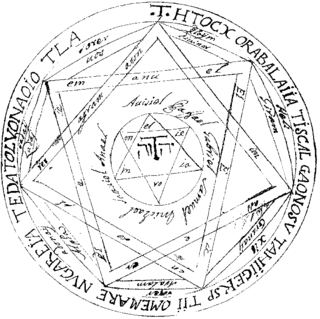
The Key of Solomon, also known as The Greater Key of Solomon, is a pseudepigraphical grimoire attributed to King Solomon. It probably dates back to the 14th or 15th century Italian Renaissance. It presents a typical example of Renaissance magic.

There have been various attempts at the classification of demons within the contexts of classical mythology, demonology, occultism, and Renaissance magic. These classifications may be for purposes of traditional medicine, exorcisms, ceremonial magic, witch-hunts, lessons in morality, folklore, religious ritual, or combinations thereof. Classifications might be according to astrological connections, elemental forms, noble titles, or parallels to the angelic hierarchy; or by association with particular sins, diseases, and other calamities; or by what angel or saint opposes them.
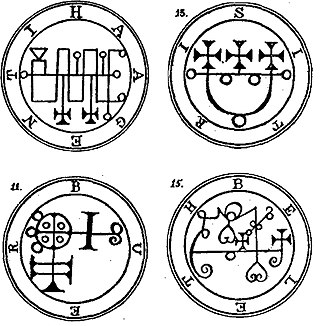
A sigil is a type of symbol used in magic. The term usually refers to a pictorial signature of a deity or spirit. In modern usage, especially in the context of chaos magic, a sigil refers to a symbolic representation of the practitioner's desired outcome.
The Sworn Book of Honorius is a medieval grimoire purportedly written by Honorius of Thebes. The Latin word juratus, which is typically translated "sworn", is intended to mean "oathbound". It was allegedly the grimoire of Pope Honorius I, hence its name.

The Seal of Solomon or Ring of Solomon is the legendary signet ring attributed to the Israelite king Solomon in medieval mystical traditions, from which it developed in parallel within Jewish mysticism, Islamic mysticism and Western occultism.

The angel Jophiel, also called Iophiel, Iofiel, Jofiel, Yofiel, Youfiel, Zophiel and Zuriel, is an archangel in Christian and Jewish angelology. Jophiel is associated with beauty, art, and wisdom.

The Simon Necronomicon is a grimoire allegedly written by "Simon" a.k.a. Peter Levenda. Materials presented in the book are a blend of ancient Middle Eastern elements, with allusions to the writings of H. P. Lovecraft and Aleister Crowley, woven together with a story about a man known as the "Mad Arab".
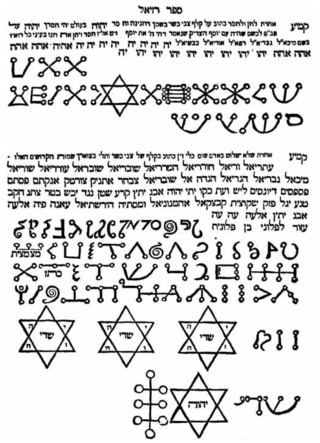
Sefer Raziel HaMalakh is a grimoire of Practical Kabbalah from the Middle Ages written primarily in Hebrew and Aramaic. Liber Razielis Archangeli, its 13th-century Latin translation produced under Alfonso X of Castile, survives.

The Arbatel De Magia Veterum is a Latin grimoire of Renaissance ceremonial magic published in 1575 in Switzerland.
Shem HaMephorash, meaning "the explicit name," is originally a Tannaitic term describing the Tetragrammaton. In Kabbalah, it may refer to a name of God composed of either 4, 12, 22, 42, or 72 letters, the latter version being the most common.
Semiphoras and Schemhamphorash is the title of an occult or magic text of Jewish provenance, published in German by Andreas Luppius in 1686. It was based on the earlier Latin text, Liber Semiphoras attributed to Solomon, which Luppius augmented heavily with passages from Agrippa De occulta philosophia and other sources.
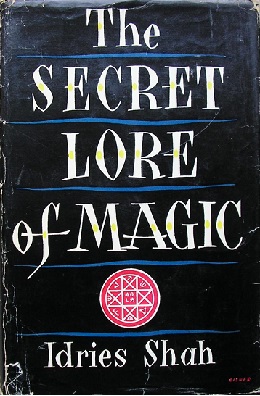
The Secret Lore of Magic is a book by Idries Shah on the subject of magical texts. First published in 1957, it includes several major source-books of magical arts, translated from French, Latin, Hebrew and other tongues, annotated and fully illustrated with numerous diagrams, signs and characters. Together with Oriental Magic, which appeared in the preceding year, it provided an important literary-anthropological survey of magical literature and is a comprehensive reference for psychologists, ethnologists and others interested in the rise and development of human beliefs.

Frederick Hockley was a British occultist and scryer who was a London-based Freemason and a member of the Societas Rosicruciana in Anglia.
The Magical Treatise of Solomon, sometimes known as Hygromanteia or Hygromancy of Solomon, the Solomonikê (Σολομωνική), or even Little Key of the Whole Art of Hygromancy, Found by Several Craftsmen and by the Holy Prophet Solomon, refers to a group of similar late Byzantine-era grimoires purporting to contain Solomon's instructions to his son Rehoboam on various magical techniques and tools to summon and control different spirits, those spirits' powers, astrological beliefs, select charms, different means of divination, and the magical uses of herbs.

The Grand Albert is a grimoire that has often been attributed to Albertus Magnus. Begun perhaps around 1245, it received its definitive form in Latin around 1493, a French translation in 1500, and its most expansive and well-known French edition in 1703. Its original Latin title, Liber secretorum Alberti Magni de virtutibus herbarum, lapidum et animalium quorumdam, translates to English as "the book of secrets of Albert the Great on the virtues of herbs, stones and certain animals". It is also known under the names of The Secrets of Albert, Secreta Alberti, and Experimenta Alberti.
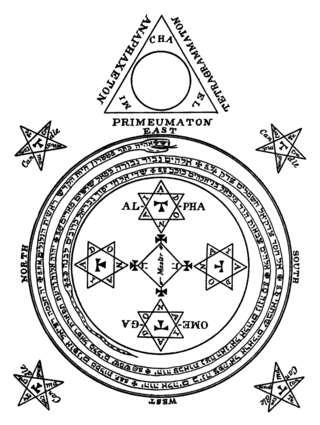
Goetia is a type of European sorcery, often referred to as witchcraft, that has been transmitted through grimoires—books containing instructions for performing magical practices. The term "goetia" finds its origins in the Greek word "goes", which originally denoted diviners, magicians, healers, and seers. Initially, it held a connotation of low magic, implying fraudulent or deceptive mageia as opposed to theurgy, which was regarded as divine magic. Grimoires, also known as "books of spells" or "spellbooks," serve as instructional manuals for various magical endeavors. They cover crafting magical objects, casting spells, performing divination, and summoning supernatural entities like angels, spirits, deities, and demons. Although the term "grimoire" originates from Europe, similar magical texts have been found in diverse cultures across the world.




















